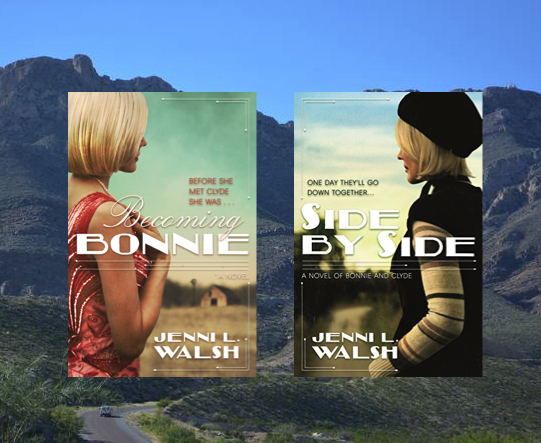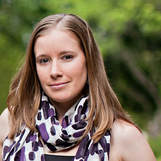Interview with Jenni L. Walsh on The Highwaymen and Bonnie and Clyde

I recently watched The Highwaymen, Netflix's movie about the lawmen who pursued Bonnie and Clyde, starring Kevin Costner, Woody Harrelson, and Kathy Bates. "The outlaws made headlines. The lawmen made history. From director John Lee Hancock (The Blind Side), THE HIGHWAYMEN follows the untold story of the legendary detectives who brought down Bonnie and Clyde. When the full force of the FBI and the latest forensic technology aren't enough to capture the nation's most notorious criminals, two former Texas Rangers (Kevin Costner and Woody Harrelson) must rely on their gut instincts and old school skills to get the job done." ( Netflix)
As soon as I finished, I just had to talk to Jenni L. Walsh, author of Becoming Bonnie and Side by Side: A Novel of Bonnie and Clyde, two works of historical fiction about the infamous couple. She graciously agreed to an interview about the movie and Bonnie and Clyde.
Becoming Bonnie is the untold story of how wholesome Bonnelyn Parker became half of the infamous Bonnie and Clyde duo.
"A compelling account of a nation and a life in disarray--readers will feel for Bonnelyn as she finds herself scrabbling for survival in a world turned upside down." - Lauren Willig, NY Times bestselling author
Side by Side is Book 2 in the "Bonnie" series, but can be read as a standalone novel.
"Full of charm and sly humor, SIDE BY SIDE tells the story of Bonnie and Clyde’s slide from lovebirds to jailbirds—and what an action-packed story it is! Vivid storytelling and a few shots of humanity breathe new life into this notorious duo. This book should be on everyone's "most wanted" list this summer." -- Elise Hooper, author of The Other Alcott
On to the interview!
LL: What did The Highwaymen get right?
JW: An element to consider with Bonnie and Clyde lore is that there were various people, with various motivations, from various sides of the law involved in the telling of Bonnie and Clyde’s encounters. For example, there were members of the Barrow Gang who altered the happenings while in court to receive a lessened sentence, or there were eyewitnesses eager for their own fifteen minutes of fame, or family members who simply couldn’t see Bonnie or Clyde as others saw them, or newspapers who sometimes fabricated stories to sell more copies. But, in general, while watching, I though the research for The Highwaymen was sound, much more sound than the 1967 Bonnie and Clyde film, at least.
LL: What did it get wrong?
JW: Bonnie, in a way. My books are written from Bonnie’s point of view, so they are inherently more sympathetic to her. I made a conscious effort not to glamourize the duo, something else The Highwaymen did well, in my opinion, but my novels display an understanding of Bonnie and Clyde’s actions as she depicts her desires, guilt, remorse, and ambitions. With all that being said, I don’t believe Bonnie went along with Clyde simply because she was bored, which is often how she is depicted. Also, Bonnie never took a life, as she was shown to do in the film. Some people even said that Bonnie never fired a gun, but my conclusions don’t align on that point.
LL: One scene that stuck with me was all the people flocking to Bonnie & Clyde’s car as if they were celebrities. It said 20,000 people attended Bonnie’s funeral, 15,000 attending Clyde’s. What made them so beloved? And why was Bonnie more loved?
JW: Bonnie and Clyde’s crime spree fell during two significant happenings. The first was the depression. The second was the invention of wire photos. That meant that photographs of Bonnie and Clyde were shared across the country through timely facsimile telegraphs – and were subsequently printed in newspapers across the country. It was likely, on any given day, to see Bonnie and Clyde’s face on the front page. They were, for better or worse, the equivalent of a soap opera. And, during the depression, many people sought out Bonnie and Clyde as both entertainment and as a distraction.
LL: Why has the duo captivated us for so long?
JW: I think it comes down to the fact that Bonnie and Clyde had a “face,” they were young – only 23 and 25 when they died, and many equated them as the era’s “Robin Hood.”
LL: I felt The Highwaymen was an effort to demystify the couple, yet I don’t think they succeeded. If anything, it made me want to know more about Bonnie and Clyde. I think not showing them increased their mystique. Do you agree?
JW: Yes, I’d agree. Although, I liked the fact that Bonnie and Clyde were shown very little. The story was very much Frank Hamer’s so I think it would’ve been too much of a departure from his storyline to fully bring to life Bonnie and Clyde’s complicated story.
LL: The movie shows very few women, but I was surprised that the few they showed were so strong. I’m thinking here of the Governor of Texas and also Frank Hamer’s wife, Gladys. Do you think they were representative of women in their time/place or the exception? Meaning, was there space in society for women of the old west to be tough and independent?
JW: I think by the 1930s, the fortitude of women had been strengthening for many decades. In the 19thcentury, we often heard only of outliers. Calamity Jane. Annie Oakley. And, I’m currently working on a novel about Eleanor Dumont, another notorious woman. As we entered the 20thcentury, we had a greater number of women breaking “the norm” while aiding in the Great War, then during the liberations of the 1920s. Even during the hardships of the depression, or maybe because of it, I think it provided an even greater opportunity for independence and grit.
LL: Lastly, your books focus on Bonnie herself and the relationship between the couple. Can you speak about your research, the books, anything you want readers to know?
JW: It was a challenge to bring Bonnie to life. The idea to make her my protagonist blossomed when I realized I didn’t know much about her as a person. She was simply lumped in with Clyde. And I wondered what would make someone willing to turn her life upside down for a felon, especially after I learned that Bonnie’s upbringing was a wholesome one. It was that background that lent itself to the storyline of Becoming Bonnie, which is Bonnie’s story before Clyde and as she chose Clyde.
In Side by Side, I continued to explore her decisions, including remaining with Clyde after she spends a few months in prison after a robbery gone wrong. While Bonnie’s origin story is greatly fictionalized, as there wasn’t a lot of source material about her earlier life, I relied heavily on diaries, memoirs, court records, first-person accounts, historians, Bonnie and Clyde experts, and Bonnie’s poem’s while crafting Bonnie’s crime spree story in Side by Side. Though, I’ll remind you, sources couldn’t always be counted on for their accuracy. In fact, I’m not certain there’s a fully accurate depiction of Bonnie and Clyde out there. It’s likely that information perished with the duo on May 23, 1934.
Watch the movie, read the books, and let me know what you think! Act quickly--BECOMING BONNIE is currently on a $1.99 promotion for Kindle or Nook.
Jenni L. Walsh worked for a decade enticing readers as an award-winning advertising copywriter before becoming an author. Her passion lies in transporting readers to another world, be it in historical or contemporary settings. She is a proud graduate of Villanova University, and lives in the Philly suburbs with her husband, daughter, son, and newfypoo. She is also the author of Becoming Bonnie and the forthcoming middle grade series She Dared.

